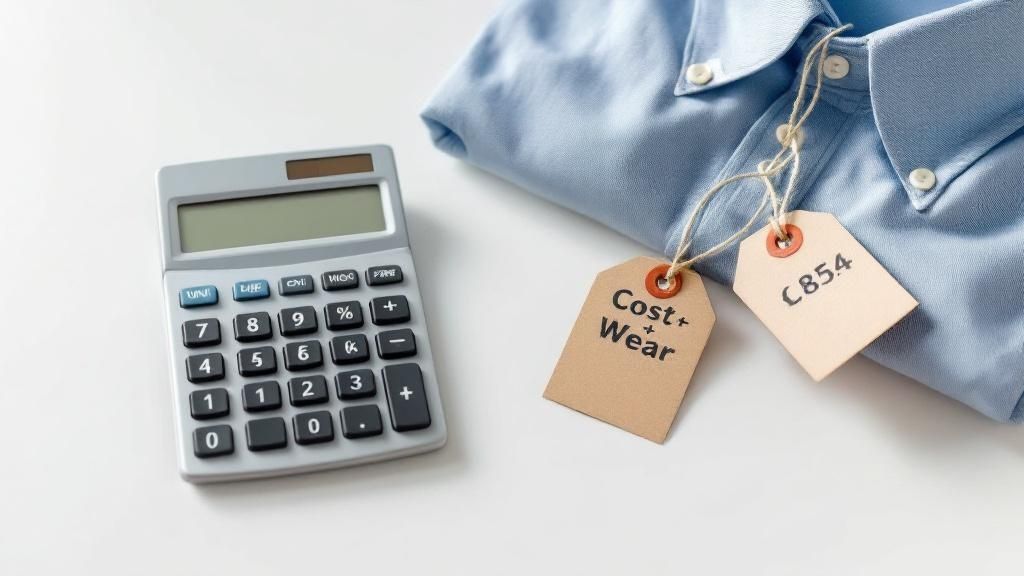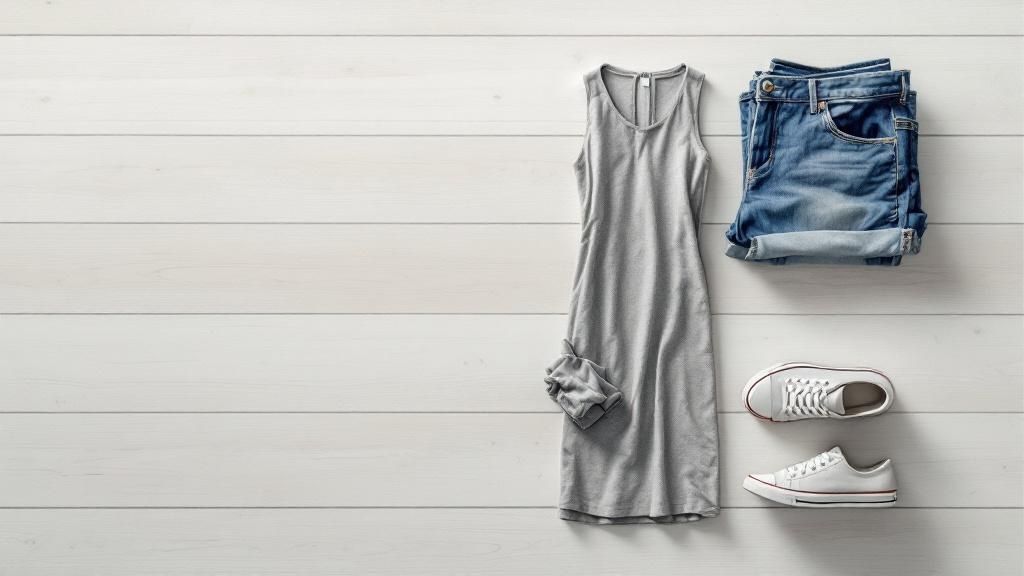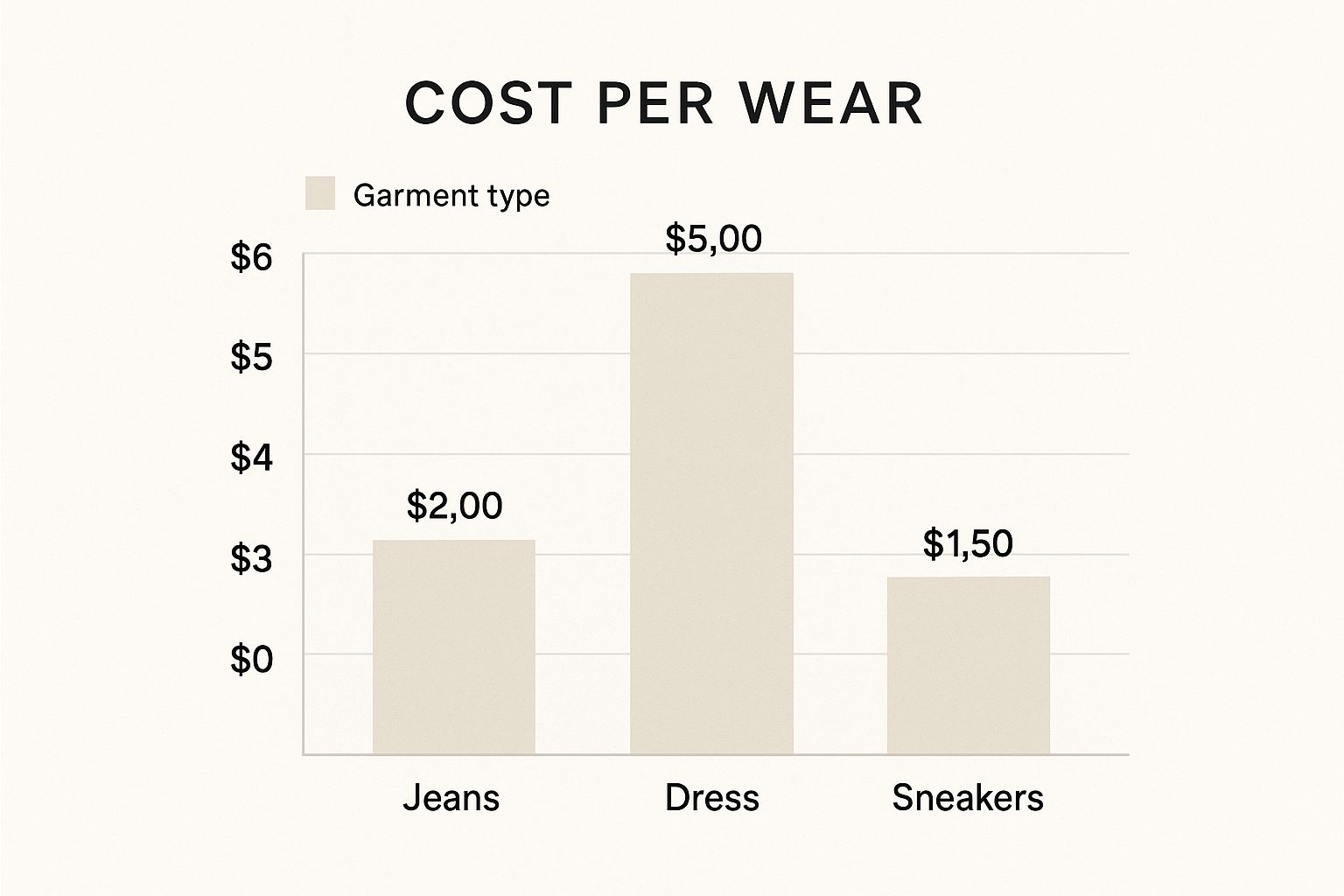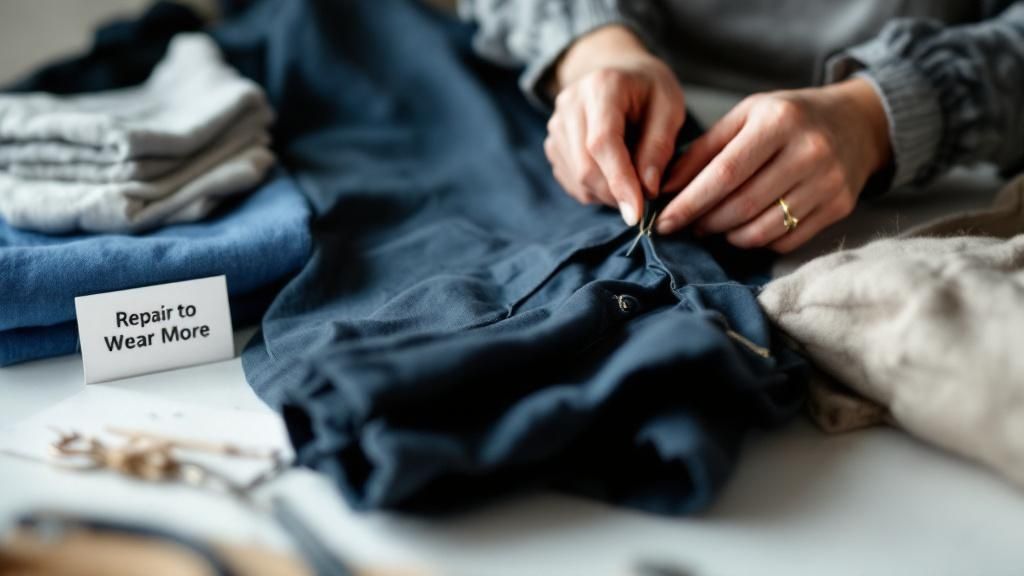Mastering The Cost Per Wear Calculator Basics
Smart shoppers in the UK know that the initial price isn't the only factor to consider. True value lies in understanding the cost per wear (CPW). This simple metric can change how you view your wardrobe and spending. It helps you look beyond the upfront cost and evaluate the long-term value of each item.
Understanding The Core Concept of CPW
Calculating the cost per wear is simple: divide the item's price by the estimated number of times you'll wear it. For example, a £50 dress worn 25 times has a CPW of £2. This straightforward calculation reveals the true cost of your clothing over time. Focusing on CPW helps you make more sustainable and budget-friendly fashion choices.
In the UK, the concept of cost per wear (CPW) is gaining popularity as a tool for sustainable fashion. This metric helps consumers evaluate the value of clothing by dividing the purchase price by the number of times they wear it. For example, a £30 jumper worn 10 times has a CPW of £3. Learn more about CPW: What is Cost Per Wear in Fast Fashion and Slow Fashion?
Putting CPW Into Practice: Real-World Examples
Let's compare a £200 coat worn 50 times a year for five years (250 wears) to a £30 jumper worn 10 times. The coat's CPW is £0.80, while the jumper's is £3. This shows that the seemingly pricier coat offers better long-term value. Also, consider factors like durability and style. A classic, well-made coat can last for years, lowering its CPW further.
CPW isn't just about comparing prices. It encourages mindful purchasing. Knowing you need to wear an item several times to get good value discourages impulse buys. This changed perspective creates a more curated, sustainable wardrobe filled with pieces you love and wear frequently. For tips on garment care: How to master clothing care symbols.
Factors Beyond The Basic Calculation
The basic formula provides a good starting point, but other factors affect CPW. Consider the cost of care. Dry cleaning adds to a garment's overall cost, impacting its CPW. Repairs also matter. A quality item might need occasional repairs, which should be included in the total cost.
Understanding garment care and selecting durable pieces can optimize your CPW. Factoring in these additional costs gives a more accurate picture of an item’s true cost. This comprehensive approach allows you to make smart decisions that align with your budget and style.
Investment Pieces Versus Fast Fashion Economics

The cost per wear calculator reveals the surprising financial differences between investment pieces and fast fashion. Many believe that buying cheaper items is the best way to save money. However, calculating cost per wear often shows the opposite is true. Investing in higher-quality, longer-lasting items frequently results in greater savings over time.
The Illusion of Cheap Fast Fashion
Fast fashion attracts shoppers with low prices. However, these seemingly inexpensive items often hide a significant downside: their poor quality and short lifespan. This means you replace them frequently, leading to higher overall spending. Furthermore, the constant cycle of buying and discarding contributes to textile waste and harms the environment.
The Power of Durability and Repairability
Investment pieces, while more expensive upfront, prioritize quality and durability. They are made to last for years, or even decades, if cared for properly. This extended lifespan significantly reduces their cost per wear. For instance, a pair of £210 quality jeans worn twice a week for five years may seem pricey initially. However, factoring in a potential £25 repair cost, the cost per wear comes down to approximately 45 pence over 520 wears. More information and calculations can be found at the Cost Per Wear Calculator. Many investment pieces are also designed to be repaired, further extending their use and lessening their environmental impact. This focus on longevity contrasts sharply with the disposable nature of fast fashion.
Timeless Style Versus Fleeting Trends
Investment pieces also emphasize timeless style. While fast fashion follows fleeting trends, investment pieces embrace classic designs that remain stylish season after season. This allows you to wear these items for years without them looking dated. As a result, their cost per wear decreases with each use, offering excellent value. For those interested in learning more about investing in long-lasting style, resources like How to master investment bags provide valuable insights.
When to Splurge and When to Save
Understanding cost per wear helps you make informed decisions about when to invest and when to choose less expensive options. Investing in high-quality basics like a well-tailored coat or durable shoes makes good financial sense because you'll wear them often. On the other hand, trend-driven items are better suited for budget-friendly purchases as their popularity may be short-lived. This strategic approach lets you build a wardrobe that balances cost, style, and sustainability.
Calculating the True Cost: Beyond the Basics
While the basic cost per wear formula is a good starting point, consider the bigger picture of your wardrobe. Think about an item's versatility and how often you realistically expect to wear it. Honest self-assessment is essential for accurate cost per wear calculations. By considering these factors, you can refine your shopping habits and curate a wardrobe filled with pieces you love and wear regularly.
Solving The UK's Fashion Waste Problem With Smart Calculations

The UK discards a substantial amount of clothing annually, contributing to landfill waste and environmental harm. A simple tool, the cost per wear (CPW) calculator, offers a practical solution. By focusing on the long-term value of clothes instead of the initial price, we can make more sustainable choices.
How CPW Fights Fast Fashion
Fast fashion encourages a buy-discard cycle. Clothes are worn a few times, then discarded. The CPW calculator helps break this cycle. By calculating the CPW, we see the true cost of each item over its lifespan.
For example, a cheap £10 top worn twice has a CPW of £5. A £50 top worn 50 times has a CPW of £1. This demonstrates that investing in higher-quality, longer-lasting garments is often more economical. It also helps build a sustainable wardrobe. For more insights into sustainable luxury fashion, check out this article: How to master sustainable luxury fashion.
Changing Your Relationship With Clothes
The CPW calculator isn't just about numbers. It's about changing how we relate to our clothes. It encourages appreciating each item's value and making mindful purchases. Studies show UK consumers don't wear over 70% of their wardrobe items. This highlights a significant opportunity for CPW to influence buying decisions and reduce waste. Learn more about shopping sustainably with the CPW calculator: Shop Smart, Sustainably With Our Cost Per Wear Calculator. It means thinking twice before buying something worn only once or twice.
Building a Sustainable Wardrobe
Using a CPW calculator leads to a more curated and sustainable wardrobe. It helps choose items reflecting personal style and that will last. This also reduces impulse buying, as we consider an item's long-term value.
This conscious approach benefits our wallets and the environment. Choosing quality over quantity and wearing clothes more often contributes to a more sustainable fashion industry. This, in turn, reduces textile waste generated in the UK.
From Impulse Buys to Intentional Purchases
The cost per wear calculator is a powerful tool for breaking free from impulse buys and fast fashion. It empowers intentional purchases based on value, durability, and personal style. This mindset shift fosters a more sustainable approach to fashion and helps reduce the UK's fashion waste.
Best Cost Per Wear Calculator Tools And Apps
Calculating your cost per wear (CPW) is a simple equation: price divided by the number of times you wear an item. But finding the right calculator to help you crunch those numbers can make a difference. Some offer extra features that can be really helpful in tracking your spending and building a more mindful wardrobe. Let's explore a few options, from quick online tools to more involved wardrobe tracking apps.
Simple Online Cost Per Wear Calculators
For quick calculations on the go, a basic online CPW calculator is perfect. These typically require just the item's price and your estimated number of wears. They're great for those on-the-spot decisions while you're shopping online or browsing in stores. Many retailers, especially those focused on sustainable fashion, offer these calculators directly on their websites.
- Pros: Easy to use, readily available, perfect for quick estimations
- Cons: Limited features, may not track additional costs like cleaning or repairs
Wardrobe Tracking Apps With CPW Features
If you're looking for something more robust, several apps provide more comprehensive wardrobe management, including CPW tracking. These apps allow you to catalogue your clothes, put together outfits, and even calculate the overall CPW of your entire wardrobe. Popular choices include Stylebook and Closet+.
- Pros: Detailed tracking, outfit logging, in-depth wardrobe analysis
- Cons: Can require time to set up, some features may require a paid subscription
Spreadsheet Templates For CPW Enthusiasts
For those who prefer a more hands-on and customizable approach, building your own spreadsheet is a great way to go. You have complete control to track additional costs, such as dry cleaning, and analyze your spending patterns over time.
- Pros: Highly customizable, allows for granular analysis
- Cons: Requires some spreadsheet knowledge, involves manual data entry
To help you choose the best tool for your needs, here's a comparison table of some popular CPW calculator options.
To help you decide which CPW calculator is right for you, I've compiled a comparison table outlining the key features and benefits of each type of platform.
Popular Cost Per Wear Calculator Platforms
| Platform | Free/Paid | Key Features | Best For |
|---|---|---|---|
| Online Calculators | Free | Basic CPW calculation, readily available | Quick estimations, on-the-spot decisions |
| Wardrobe Tracking Apps | Paid/Free | Comprehensive wardrobe management, outfit logging | Detailed tracking, wardrobe analysis |
| Spreadsheet Templates | Free | Customizable tracking, in-depth analysis | Users comfortable with spreadsheets, detailed analysis |
As you can see, each platform caters to different needs and levels of engagement with CPW tracking. Choosing the right one will ultimately depend on your personal preferences and how deeply you want to delve into managing your wardrobe costs.
Choosing The Right Tool For You
Ultimately, the best cost per wear calculator is the one that fits your lifestyle and goals. If you're just getting started, a simple online calculator might be a great first step. As you become more familiar with the concept and want more in-depth information, a wardrobe tracking app or spreadsheet can offer greater insight into your clothing investments.

This chart visually compares the cost per wear for three common clothing items: jeans, a dress, and sneakers. Notice how even though the dress has a higher initial price tag, its cost per wear isn't necessarily lower than the jeans or sneakers. This highlights the importance of considering how often you'll wear an item. This empowers you to make smarter purchasing decisions based on long-term value. Don’t forget those added costs like repairs, alterations, and dry cleaning – these can significantly impact the true cost per wear, making a seemingly budget-friendly item less economical in the long run.
Building Your Strategic Wardrobe Using Cost Per Wear Data
Now for the fun part: building a stylish and efficient wardrobe using cost per wear (CPW) data. This means understanding how to evaluate your current clothes and plan future purchases based on CPW. The goal? A wardrobe that looks fantastic and fits your budget.
Conducting a Wardrobe Audit
First up is a wardrobe audit. This involves examining each item, calculating its CPW, and identifying your wardrobe workhorses – the pieces you wear often and provide excellent value. You'll also find the items that aren't getting enough use. This process can be eye-opening, revealing ways to improve your spending. A wardrobe audit isn’t simply about decluttering; it’s about understanding the real value of your clothing.
Setting Realistic CPW Targets
After auditing your wardrobe, you can set realistic CPW targets for different clothing types. Everyday basics, like jeans or a white shirt, should have a lower CPW because you wear them frequently. Aiming for a CPW of under £1 for these items is a good start. Special occasion pieces, worn less often, will naturally have a higher CPW. Understanding this difference is crucial for a balanced wardrobe.
To make smarter purchases, use the following table as a benchmark:
To help you make informed purchasing decisions, let's take a look at some recommended CPW benchmarks for different types of clothing.
Target Cost Per Wear by Clothing Category
| Clothing Type | Target CPW Range | Expected Wear Frequency | Quality Indicators |
|---|---|---|---|
| Everyday Basics | <£1 | High (Weekly/Daily) | Durable fabric, versatile design |
| Workwear | £1-£3 | Medium (2-3 times/week) | Quality construction, classic style |
| Special Occasion | >£3 | Low (Few times/year) | High-quality materials, unique design |
| Outerwear (Coats) | <£2 | Medium (Seasonal) | Durable material, timeless style |
This table provides a helpful framework for setting realistic CPW targets and recognizing quality indicators when shopping. Remember, aiming for these CPW ranges can help you maximize the value of your wardrobe over time.
Building a Capsule Wardrobe
A capsule wardrobe, based on versatile, high-quality items, is a great way to minimize CPW. By focusing on pieces that can be mixed and matched, you get more wear from each item. This fosters creativity and helps you develop your style without constantly buying new things. Check out our guide on Building A Professional Wardrobe for more tips on building a stylish and versatile capsule collection. You might also find this helpful: How to Master a Capsule Wardrobe.
Evaluating Future Purchases
Before any new purchase, think about its potential CPW. Ask yourself: How often will I realistically wear this? Does it fit with my existing wardrobe? Is the quality worth the price? This helps avoid impulse buys and ensures every new item contributes to a lower overall CPW.
Planning Seasonal Updates and Maintenance
Regularly evaluating your wardrobe and planning seasonal updates helps maintain a low CPW. This includes repairing or altering existing pieces to extend their life, and choosing new items that fill gaps in your wardrobe. This proactive approach keeps your wardrobe evolving with your style and needs, without overspending.
Maximizing Wear Frequency And Garment Lifespan

Getting the most bang for your buck with your clothing isn't just about finding great deals. It's also about making smart choices about how you wear what you own. Even carefully calculated cost per wear sometimes can't prevent those pricier pieces from gathering dust in the back of our closets. This section will explore how to maximize the use of your clothes, extending their lifespan, and getting the most value for your investment. As a bonus, you’ll be contributing to more sustainable fashion practices.
Overcoming Barriers to Wearing Your Clothes
There are a number of reasons why we might not wear certain items as often as we’d like. Practicality plays a role; perhaps an item requires special cleaning, making it a less convenient option for everyday wear. Psychological barriers can be just as impactful. Many of us feel self-conscious about repeating outfits, especially bolder, more distinctive pieces.
These barriers aren’t insurmountable. Simple strategies can make a big difference. Planning outfits in advance, for example, can help you incorporate less frequently worn pieces into your weekly rotation. This removes the element of last-minute decision fatigue that often leads us to reach for the same familiar items time after time.
Styling Techniques for a Fresh Perspective
A great way to increase wear frequency is to look at your existing wardrobe in new ways. This is where creative styling techniques come in. Experiment with pairing items in unexpected combinations, layering pieces differently, or using accessories to transform an outfit. Think about that dress you only wear for special occasions. Could you style it more casually with sneakers and a denim jacket for daytime wear? You might be surprised by how versatile your existing pieces can be.
Proper Care for Extended Lifespan
The care you give your clothes has a direct impact on how long they last, impacting your overall cost per wear. Paying close attention to care instructions, washing clothes less often (when appropriate), and storing them properly can significantly reduce wear and tear. Instead of ironing delicate fabrics, try a clothes steamer to avoid heat damage. Investing in quality hangers that maintain the shape of your garments can also help them last longer. Small changes in your care routine can have a noticeable impact.
Strategic Alterations for a Perfect Fit
Our bodies change, and sometimes our favorite clothes no longer fit the way they used to. Don't banish these items to the back of the closet! Consider having them altered. A skilled tailor can adjust hems, take in waists, or even reshape a garment to give it a new lease on life. This allows you to keep wearing beloved pieces and keeps clothing out of landfills. For further reading on creating a versatile wardrobe, you might be interested in: How to master a capsule wardrobe.
Real-World Examples: Learning From Others
Plenty of people have achieved remarkably low cost per wear figures by maximizing their clothing's use. Their strategies can provide inspiration. The “one in, one out” rule, where one item must be removed from the wardrobe for every new item purchased, is one popular technique. This prevents wardrobe overload and encourages thoughtful purchases. Another approach is to document outfits, creating a visual catalog of styling possibilities. This can break you out of outfit ruts and inspire experimentation. By learning from others and adapting their methods to your style, you can cultivate a wardrobe you love and wear frequently. This is a key step toward a more sustainable and financially savvy approach to fashion.
Key Takeaways
This section provides a practical action plan for implementing cost per wear (CPW) principles. We’ll equip you with checklists and decision-making frameworks to guide you on your journey to a more cost-effective wardrobe. We'll cover benchmarks for success, warning signs to watch out for, and milestones to celebrate. Each takeaway offers specific, actionable steps, from your first CPW calculation to building long-term, sustainable shopping habits. We’ll also discuss realistic timelines for seeing results and how to stay on track when tempted by old spending patterns.
Understanding the True Value of Your Wardrobe
The first key takeaway is understanding the real value of your clothing. This goes beyond the initial price tag and delves into the concept of CPW. By calculating how much each item truly costs you per wear, you empower yourself to make more informed purchase decisions. This shift in perspective is fundamental to building a wardrobe that is both stylish and budget-friendly.
-
Action Step: Conduct a thorough wardrobe audit. Calculate the CPW for every item. This exercise will highlight your best value items and identify those that aren't performing well.
-
Benchmark: Aim for a CPW below £1 for frequently worn items like everyday basics.
-
Warning Sign: A wardrobe full of unworn clothes with a high CPW.
Making Informed Purchasing Decisions
The next takeaway focuses on using CPW data to guide your future shopping choices. Before buying anything new, calculate its potential CPW. Consider how often you’ll realistically wear the item and how well it integrates with your existing wardrobe. This proactive approach helps avoid impulsive buys. It ensures that every new addition contributes positively to your overall wardrobe value.
-
Action Step: Before making a purchase, ask yourself these key questions: How often will I realistically wear this? Does it complement my existing wardrobe? Does its quality justify the price, considering its potential CPW?
-
Benchmark: Refer to the Target CPW table in the previous section as a guideline for different clothing categories.
-
Warning Sign: Regularly exceeding your target CPW for specific types of clothing.
Maximising Wear Frequency and Garment Lifespan
This takeaway emphasizes getting the most out of the clothes you already own. This involves wearing your items more frequently and implementing good care practices to extend their lifespan. This not only contributes to a lower CPW but also helps reduce fashion waste.
-
Action Step: Plan your outfits in advance to incorporate less frequently worn pieces. Experiment with different styling combinations to maximize the versatility of your wardrobe and create fresh looks. Follow proper care instructions to keep your clothes in top condition.
-
Benchmark: Strive to wear every item in your wardrobe on a regular basis.
-
Warning Sign: Clothes remaining unworn for extended periods, even if they have a low calculated CPW.
Embracing Sustainable Shopping Habits
The final takeaway involves transitioning from fast fashion to a more sustainable approach to building your wardrobe. By prioritizing quality over quantity and investing in long-lasting pieces, you'll reduce textile waste and cultivate a personal style that transcends short-lived trends.
-
Action Step: Implement the "one in, one out" rule. For every new item you bring into your wardrobe, remove one that you no longer wear or need.
-
Benchmark: Gradually decrease the number of fast fashion purchases you make and opt for higher-quality, durable pieces.
-
Milestone: Celebrate achieving a significantly lower overall CPW across your entire wardrobe.
By focusing on these key takeaways, you can transform your relationship with fashion, build a wardrobe that truly reflects your style and needs, and minimize your environmental impact. Ready to elevate your wardrobe and adopt a smarter shopping strategy? Explore Feinheit FZ LLC’s curated collection of luxury and premium brands at TheFeinheit.com for timeless pieces that stand the test of time. Enjoy free global shipping and a 5% discount with code LUXE5 or WELCOME10 for subscribers.

